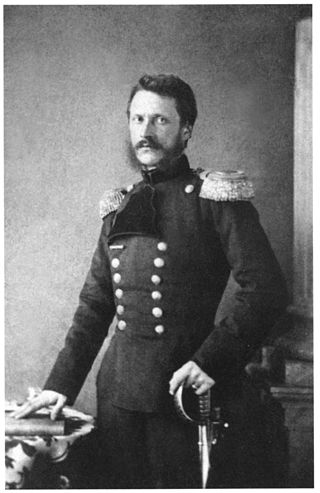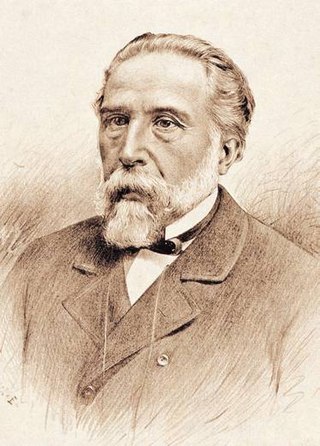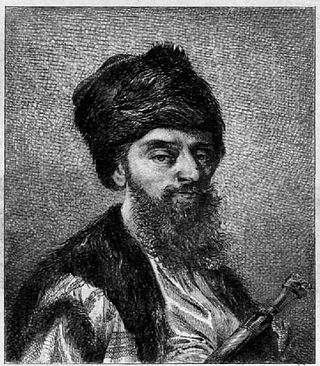Related Research Articles
Year 1447 (MCDXLVII) was a common year starting on Sunday of the Julian calendar.

Alexandru Ioan Cuza was the first domnitor (Ruler) of the Romanian Principalities through his double election as prince of Moldavia on 5 January 1859 and prince of Wallachia on 24 January 1859, which resulted in the unification of the two states. He was a prominent figure of the Revolution of 1848 in Moldavia. Following his double election, he initiated a series of reforms that contributed to the modernization of Romanian society and of state structures.

Moldavia is a historical region and former principality in Central and Eastern Europe, corresponding to the territory between the Eastern Carpathians and the Dniester River. An initially independent and later autonomous state, it existed from the 14th century to 1859, when it united with Wallachia as the basis of the modern Romanian state; at various times, Moldavia included the regions of Bessarabia, all of Bukovina and Hertsa. The region of Pokuttya was also part of it for a period of time.

Wallachia or Walachia is a historical and geographical region of Romania. It is situated north of the Lower Danube and south of the Southern Carpathians. Wallachia is traditionally divided into two sections, Muntenia and Oltenia. Dobruja could sometimes be considered a third section due to its proximity and brief rule over it. Wallachia as a whole is sometimes referred to as Muntenia through identification with the larger of the two traditional sections.

Connop Thirlwall was an English bishop and historian.

Ion Constantin Brătianu was one of the major political figures of 19th-century Romania. He was the son of Dincă Brătianu and the younger brother of Dimitrie, as well as the father of Ionel, Dinu, and Vintilă Brătianu. He also was the grandfather of poet Ion Pillat.
The Middle Ages in Romania began shortly after the withdrawal of the Roman legions from the former Roman province of Dacia in the late 3rd century and with the start of the Early Middle Ages and the Migration Period that followed afterwards respectively. It subsequently came to an end with the reign of Domn Michael the Brave (1593–1601) who managed, for a short time between 1599 and 1600, to rule Wallachia, Moldavia, and Transylvania together, the three principalities whose territories were to be united some three centuries later to form modern and contemporary Romania.

George Ghica founder of the Ghica family, was Prince of Moldavia in 1658–1659 and Prince of Wallachia in 1659–1660.

Ion Ghica was a Romanian statesman, mathematician, diplomat and politician, who was Prime Minister of Romania five times. He was a full member of the Romanian Academy and its president many times. He was the older brother and associate of Pantazi Ghica, a prolific writer and politician.

Demetrios Ypsilantis was a Greek army officer who served in both the Hellenic Army and the Imperial Russian Army. Ypsilantis played an important role in the Greek War of Independence, leading several key battles. He was also member of the Filiki Eteria and the younger brother of Alexander Ypsilantis.

Constantine Ypsilantis was the son of Alexander Ypsilantis, a key member of an important Phanariote family, Grand Dragoman of the Porte (1796–1799), hospodar of Moldavia (1799–1802) and Walachia (1802–1806), and a Prince through marriage to the daughter of Alexandru Callimachi.

The Cathedral of Curtea de Argeș is a Romanian Orthodox cathedral in Curtea de Argeș, Romania. It is located on the grounds of the Curtea de Argeș Monastery, and is dedicated to Dormition of the Mother of God. The building is the seat of the Archdiocese of Argeș and Muscel.
William Gordon East was an English geographer and writer. He studied at Cambridge University. He taught at the London School of Economics and Political Science.
The Early Modern Times in Romania started after the death of Michael the Brave, who ruled in a personal union, Wallachia, Transylvania, and Moldavia – three principalities in the lands that now form Romania – for three months, in 1600. The three principalities were subjected to the Ottoman Empire, and paid a yearly tribute to the Ottoman Sultans, but they preserved their internal autonomy. In contrast, Dobruja and the Banat were fully incorporated into the Ottoman Empire.

The flag and coat of arms of Moldavia, one of the two Danubian Principalities, together with Wallachia, which formed the basis for the Romanian state, were subject to numerous changes throughout their history.
Alexandru is the Romanian form of the name Alexander. Common diminutives are Alecu, Alex, and Sandu.

Romanian Catholics, like Catholics elsewhere, are members of the Catholic Church under the spiritual leadership of the Pope and Curia in Rome. The administration for the local Latin Church is centered in Bucharest, and comprises two archdioceses and four other dioceses. It is the second largest Romanian denomination after the Romanian Orthodox Church, and one of the 18 state-recognized religions. As of 2021, 5.2% of Romanians identified as Catholic. The 2012 census indicated that there were 741,276 Romanian citizens adhering to the Latin Church. Of these, the largest groups were Hungarians, Romanians, Germans and Slovaks.

The United Principalities of Moldavia and Wallachia, commonly called United Principalities or as Wallachia and Moldavia, was the personal union of the Principality of Moldavia and the Principality of Wallachia. The union was formed 5 February [O.S. 24 January] 1859 when Alexandru Ioan Cuza was elected as the Domnitor of both principalities. Their separate autonomous vassalage in the Ottoman Empire continued with the unification of both principalities. On 3 February [O.S. 22 January] 1862, Moldavia and Wallachia formally united to create the Romanian United Principalities, the core of the Romanian nation state.

The unification of Moldavia and Wallachia, also known as the unification of the Romanian Principalities or as the Little Union, happened in 1859 following the election of Alexandru Ioan Cuza as prince of both the Principality of Moldavia and the Principality of Wallachia. A potential unification between the two principalities, which shared a common Romanian ethnicity, language and culture, had been attempted to be avoided by the great powers for a long time, although it was allowed at the moment it happened. The unification of these two states began a political struggle in the new country to find out which of the two regions would obtain "supremacy" and met some opposition in Moldavia by the so-called "separatists".
References
- ↑ Claudian as an Historical Authority by J. H. E. Crees.
- ↑ W.G. East, The Union of Moldavia and Wallachia, 1859 - An Episode in Diplomatic History, Cambridge University Press (1929).
